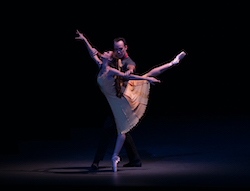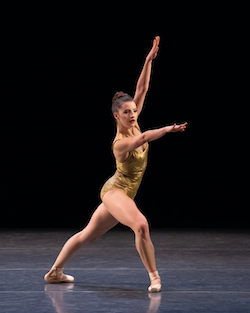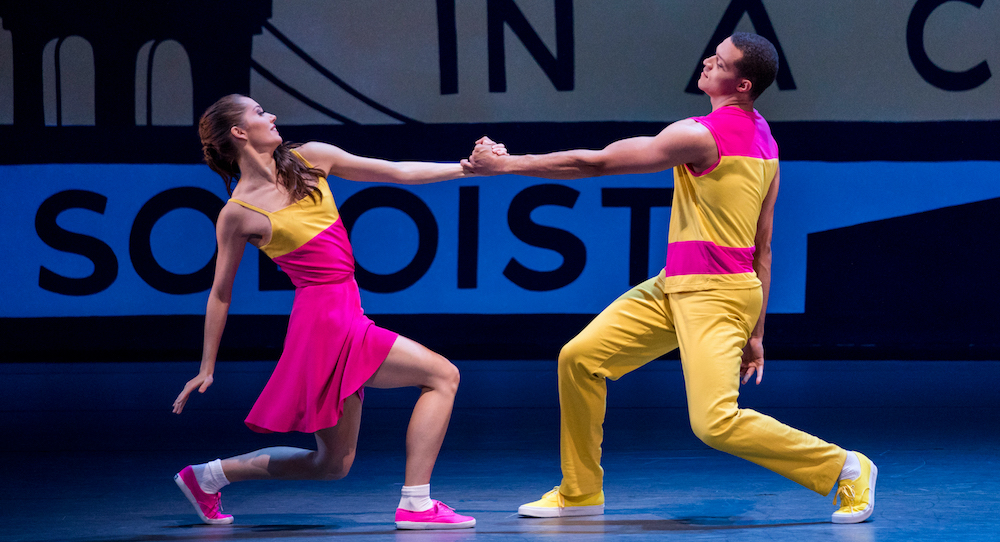March, April and May 2020.
Online (YouTube and Facebook, through www.nycballet.com)
It’s sort of striking to think how years of planning can change in a moment, with one hard and official decision. Major dance companies across the country experienced this surreal dynamic when they made the call to cancel their spring seasons due to COVID-19. New York City Ballet (NYCB), like many other companies, ensured that the show would go on — not as it normally would have, as carefully programmed long before the curtain was to rise, but in some form nonetheless.
The company shifted its season to its website, free for all to enjoy two to three days each week. While the company did request donations to help recoup financial loss from the season being cancelled, all could enjoy these performances free of cost — at a time when so many people crave the connection and catharsis that art can offer. The curation was also purposeful, offering context and knowledge around the works. That can be powerful public education around dance.
Christopher Wheeldon’s Liturgy is “an experiment in sculpting sound”, explained the website’s program notes. With the “spirituality of life in the music,” the work grew out of partnership of Wendy Whelan, Jock Soto, and Wheeldon in the studio. From the work’s very first notes, the music is full of energy, speed and drama. The lights came up on Whelan, with Soto behind her. As they begin to move, their shapes are angular but then break into softer forms. They move with an assured but fluid bird-like quality.
In spotlight, the pair moves with more traditional pas de deux shapes but also striking, innovative images. She bourées around him after rising from the illusion of a seat. With one hand on his shoulder, his head follows her path. Their connection is kinesthetic, spatial and musical. Their speed picks back up as speed in music does; the qualities of the music and the movement align; there’s a resonance in the movement matching the sustainment in the music, notes wrapping around the notes following them. Soto is sure, steady, precise and always there for his partner.
Whelan’s facility, as so many know, is of a unique and striking flavor. The artistry of her musicality and movement quality enhances the facility of her long limbs, control and remarkable pliability. She lets the music and the choreography shape her like clay, yet clay that is so very alive and intelligently attuned. Toward the end of the work, the pair returns to the shapes of the beginning. The music guides their clear shapes until the lights fades and the curtain drops. They live in the music and movement, a joining that becomes a liturgy of its own.

In Wheeldon’s Carousel, creative ingenuity shapes classic whimsy into something truly memorable. To begin the work, spotlights come up to show various characters. Key among them are a young girl walking through and a man watching her. With a slight uneasiness in the music that signals foreshadowing, one senses that there will be narrative here. Lights rise to show corps dancers circling around the two main characters. The music takes on a much more joyful feel, matching the bright and joyful colors all across the stage. The movement quality is expansive and bright. With a shift to a quartet, two pairs of partners, new movement pathways are possible with a new number of dancers.
A following men’s section has a bravado feel. With a large corps of danseurs spanning the stage, strength and finesse fill the air. Women dance in and a softer feel ensues. Throughout, the stage picture is active and full but not chaotic. The energy completely changes with a pas de deux of that same man and woman. She wears a yellow dress, plain but elegant, with a bow in her hair. There’s a quality of joy and innocence in her character, including her soft and unassuming — but assured — movement style. The romantic quality at hand implies that much has happened since we last saw them.
A tenderness is in the air until the man’s bravado surfaces; she steps away but he pulls her back. The movement takes on a more sweeping quality with drama rising in the music. The work has a spectrum of qualities for audiences to enjoy. The couple dances traditional pas de deux vocabulary with individualized inflections that build character and add drama. The corps returns to waltz and partner. Big, fun, and vernacular movement — such as ballerinas cartwheeling around — is an homage to the bright, campy feel of carnival.
With sticks, to build the representation of a merry-go-round, they circle. This is an inventive way of embodying a merry-go-round. The main male character tries to get to his female counterpart . She’s on the inside and he’s on the outside, and he’s trying to get to her. They come together in the end, but then she runs. He runs after her. This ending empowers her with having that choice to exit, and also gives the sense that the story will go on. As is true of the work at large, a classic story had unique and more modernized choices — offering something comforting in being familiar, but also something to intrigue or even to challenge.
The last weekend of the Digital Spring Season featured 21st century choreographers. Easy by Justin Peck is an homage to Jerome Robbins, the choreographer explains in an introduction video. With the feel of a modernized Fancy Free, it’s a dramatized classical ballet with modern inflections and a pinch of attitude. The stage picture is compelling, but could have used more of the stage for visual clarity at times. The costumes of bright colored sections don’t read as authentic to me; why not slightly stylized street wear? On the other hand, its color palette — matching with the backdrop — is somehow both enticing and soothing. Dancers expertly bring across easy suave and rock-solid technical work. Memorable motifs include a wave and gaze to the audience in a long arabesque, and intricate footwork leading into a leg extended to the side — long and low.

Following that is Pam Tanowitz’s Bartók Ballet. It comes right out swinging with an anxious semi-surrealism, dancers hitting unconventional shapes as string instruments sing quite quickly and somewhat atonally. Gold leotards align with the clean, polished finish of the movement. While the quick shifts from classical to modern in movement quality and shape at times feel jarring to me, the sheer majesty of what the dancers are doing with their bodies — the control, the finesse, the innovation of shape and quality — helps me get over that in less than a split second. The sheer ingenuity of it is striking and memorable. In this excerpt, the ending contributes to a creepy mechanized feel — in a perfect diagonal line, the dancers fall to the ground at the same time and in the same shape.
Gianna Riassen’s A Composer’s Holiday offers a smooth and delightful blend of the modern and classical, the elegant and lighthearted, the dramatic and movement-focused. A narrative isn’t clear, but what is clear is personality and authentic humanity — with little gestures of reaching, glances and gazes, drawing towards and away. Those moments live in harmony with movement that can awe and inspire; turns are multiple, legs rise high, and control (without rigidity) takes center stage. Formations make a clear stage picture and support the energy of the moment. Black and white costumes, somewhat nondescript in cut and style, actually tangibilize the feeling here; is there a touch of punk there? Are punk and glamour living side-by-side? All is well-constructed, yet that question remains for audience members. With dance art, that can truly be the exciting part.
By Kathryn Boland of Dance Informa.















